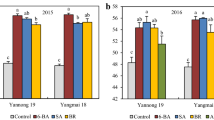Abstract
The protective effect of a synthetic terpenoid Analog of the plant hormone abscisic acid (ABA) coded LAB 173711 applied alone or in combination with the growth retardant tetcyclacis on chilling injury of rice was studied under growth chamber, greenhouse, and field conditions. The compounds were applied as a foliar spray before and after the onset of chilling treatment, as a substrate via the root system, and as a medium for seed soaking. The ABA analog increased chilling resistance in a manner similar to ABA. Combination of the analog with tetcyclacis revealed additive effects. Increased chilling resistance involved several processes: stomatal closure which reduced water loss during chilling, stabilization of the membranes, stabilization of the chlorophyll level, and stabilization of the root system. Possibilities for practical use of the compounds in rice production are discussed.
Similar content being viewed by others
References
Anderson HM, Huband NDS (1987) Improvement of winter hardiness and seedling growth of oats with seed dressings of tetcyclacis. In: Hawkins AF, Stead AD, Pinfield NJ (eds) Plant growth regulators for agricultural and amenity use. Monograph No. 36, 45–50. British Crop Protection Council, Thornton Heath
Asare-Boamah NK, Fletcher RA (1986) Protection of bean seedlings against heat and chilling injury by triadimefon. Physiol Plant 67:353–358
Capell B, Dörffling K (1989) Low temperature induced changes of abscisic acid contents in barley and cucumber leaves in relation to their water status. J Plant Physiol 135:571–575
Flores A, Dörffling K (1990) A comparative study of the effects of abscisic acid and new terpenoid abscisic acid analogues on plant physiological processes. J Plant Growth Regul 9:133–139
Flores A, Grau A, Laurich F, Dörffling K (1988) Effect of new terpenoid analogues of abscisic acid on chilling and freezing resistance. J Plant Physiol 132:362–369
Flores-Nimedez A, Vergara BS, Dörffling K (1990a) Effect of synthetic phytohormone analog on leaf water potential during chilling. IRRN 15:2, 18
Flores-Nimedez A, Dörffling K, Vergara BS (1990b) A new phytohormone analog for preventing rice membrane injury after chilling. IRRN 15:2, 19
Greaves JA, Wilson JM (1986) Assessment of the non-freezing cold sensitivity of wild and cultivated potato genotypes by chlorophyll fluorescence analysis. Potato Res 29:509–520
Grossman K, Jung J (1984) The influence of new terpenoid analogues of abscisic acid on stomatal movement and leaf senescence. Z Acker Pflanzenbau (J Agron Crop Sci) 153:14–22
Hodgson RA, Raison JK (1984) Chloroplast superoxide (O2-) radical production during low temperature stress in the light. Plant Physiol 75(Suppl):980
Moll BA, Steinback KE (1986) Chilling sensitivity on Oryza sativa: the role of protein phosphorylation in protection against photoinhibition. Plant Physiol 80:420–423
Peeler TC, Naylor AW (1988) A comparison of the effects of chilling on leaf gas exchange in pea (Pisum sativum L.) and cucumber (Cucumis sativus L.). Plant Physiol 86:143–146
Quarrie SA (1987) Use of genotypes differing in endogenous abscisic acid levels in studies of physiology and development. In: Hoad GV, Lenton JR, Jackson MB, Atkin RK (eds) Hormone action in plant development—a critical appraisal. Butterworths, London, pp 89–105
Rademacher W, Fritsch H, Graebe JE, Sauter H, Jung J (1987) Tetcyclacis and triazole-type plant growth retardants: their influence on the biosynthesis of gibberellins and other metabolic processes. Pestic Sci 21:241–252
Rikin A, Atsmon D, Gitler C (1983) Quantitation of chill-induced release of a tubelin-like factor and its prevention by abscisic acid in Gossypium hirsutum L. Plant Physiol 71:747–748
Rikin A, Atsmon D, Gitler C (1979) Chilling injury in cotton (Gossypium hirsutum L.): prevention by abscisic acid. Plant Cell Physiol 20:1537–1546
Rikin A, Blumenfeld A, Richmond AE (1976) Chilling resistance as affected by stressing environments and abscisic acid. Bot Gaz 137:307–312
Schubert J, Roeser K, Grossman K, Sauter H, Jung J (1991) Transpiration-inhibiting abscisic acid analogs. J Plant Growth Regul 10:27–32
Smillie RM, Hetherington SE (1983) Stress tolerance and stress-induced injury in crop plants measured by chlorophyll fluorescence in vivo. Chilling, freezing, ice cover, heat and high light. Plant Physiol 72:1043–1100
Zhang CL, Li PH, Brenner ML (1986) Relationship between mefluidide treatment and abscisic acid metabolism in chilled corn leaves. Plant Physiol 81:699–701
Author information
Authors and Affiliations
Rights and permissions
About this article
Cite this article
Flores-Nimedez, A.A., Dörffling, K. & Vergara, B.S. Improvement of chilling resistance in rice by application of an abscisic acid analog in combination with the growth retardant tetcyclacis. J Plant Growth Regul 12, 27–34 (1993). https://doi.org/10.1007/BF00193675
Received:
Accepted:
Issue Date:
DOI: https://doi.org/10.1007/BF00193675




